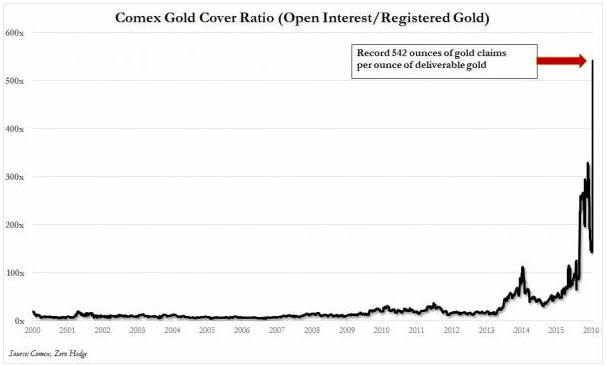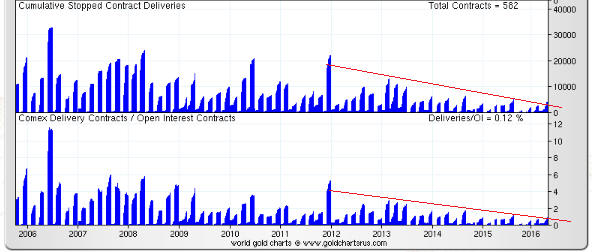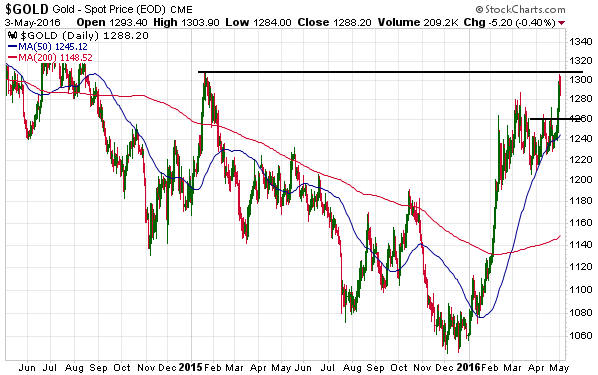This post is a modified excerpt from a recent TSI commentary.
The amount of gold flowing into and out of the SPDR Gold Trust (GLD) inventory is often portrayed as an important driver of the gold price, but it is nothing of the sort. As I’ve previously explained*, due to the way the ETF operates it can reasonably be viewed as an effect, but not a cause, of a change in the gold price. In any case, the amount of gold that shifts into and out of the GLD inventory is trivial in comparison to the overall market.
Since the beginning of December last year the average daily change in GLD’s physical gold inventory has been about 3 tonnes, or about 0.1M ounces. To most of us, 0.1M ounces of gold would represent huge monetary value (at US$1250/oz, 0.1M ounces is worth US$125M), but within the context of the global gold market it is a very small amount.
To give you an idea of how small I point out that over the same period (since the beginning of December last year) the average amount of gold traded per day via the LBMA (London Bullion Market Association) was around 20M ounces. Also over the same period, average daily trading volume on the COMEX was roughly 250K gold futures contracts. A futures contract covers 100 ounces, so the average daily trading volume on the COMEX was equivalent to about 25M ounces.
Very roughly, then, the combined average amount of gold traded per day via the facilities of the LBMA and the COMEX over the past few months was 45M ounces. This amount is 450-times greater than the average daily change in the GLD inventory and still covers only part of the overall market.
As an aside, over the past few months the average daily trading volume in GLD shares has been about 15M. A GLD share represents slightly less than 0.1 ounces of gold, so this equates to about 1.5M gold ounces. The volume of trading in GLD shares is therefore an order of magnitude more significant than the volume of physical gold going into and out of the GLD inventory, but it is still a long way from being the most influential part of the overall market.
Once you understand the scale of the overall gold market you will realise that many of the gold-related figures that are carefully tracked and often portrayed as important are, in reality, far too small to have a significant effect on price. For example, the quantity of gold that trades via the combined facilities of the LBMA and the COMEX on an average DAY is about 45-times greater than the quantity of gold sold in coin form by the US Mint in an average YEAR.
An obvious objection to the above is that I am conflating physical gold and “paper gold” (paper claims to current gold or future gold). Yes, I am doing exactly that. When considering price formation in the gold market it makes sense to consider the ‘physical’ and ‘paper’ components together because they are tightly linked by arbitrage-related trading. In particular, in the major gold-trading centres the price of a 400-oz good-delivery bar of physical gold is always closely related to the prices of futures contracts and the prices of other well-established paper claims to gold.
So, don’t be misled by analyses that focus on relatively minor shifts in physical gold location. Just because something can be counted (for example, the daily change in the GLD gold inventory) doesn’t mean it is worth counting, and just because something can’t be counted (for example, the total amounts of gold traded and hoarded by people throughout the world) doesn’t mean it isn’t important.
*My last two blog posts on the topic are HERE and HERE. The crux of the matter is that neither a rising gold price nor a rising GLD share price necessarily results in the addition of gold to GLD’s inventory. Additions of gold only happen if GLD’s share price rises relative to its net asset value and deletions of gold only happen when GLD’s share price falls relative to its net asset value, with the process driven by the arbitrage-trading of Authorised Participants.
 Print This Post
Print This Post




